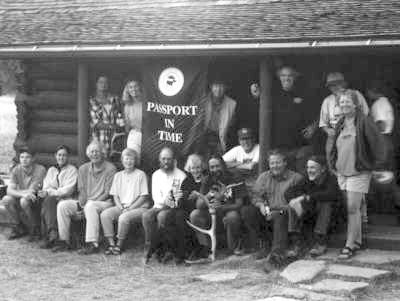Coconino Rim 2001 - Passport in Time
Main menu:
Previous Projects > States A-F
PIT on the Coconino Rim
Kaibab National Forest, Arizona, 2001
by Neil S. Weintraub, FS Archaeologist
 (Photo: Coconino Rim PIT team in front of the Hull Cabin, 2001)
(Photo: Coconino Rim PIT team in front of the Hull Cabin, 2001)The Kaibab NF Heritage Team hosted its 13th PIT project from September 10 to 16, 2001. During 1999, the heritage team and PIT volunteers investigated the Coconino Rim area, an uplifted plateau just south of the Grand Canyon. This survey identified a pattern of Pueblo III hilltop forts on finger ridges overlooking the upper basin, which is located adjacent to the South Rim of the Grand Canyon. At the end of the 1999 project, we wondered if these were truly forts, then what types of sites were they protecting?
In 2001, Kaibab NF archaeologists, Grand Canyon National Park archaeologists, and 12 PIT volunteers conducted reconnaissance surveys below these forts at elevations ranging from 6,500 to 7,200 feet. They recorded 26 new sites mostly in the pinyon-juniper-sage vegetation zones. These included artifact scatters, field houses, several large pueblos, agricultural terraces, additional hilltop forts, rock art, a possible water-catchment feature, and a Navajo camp. The complex of agricultural terraces covering 10–15 acres proved enigmatic. We intend to map these systems during a future PIT project.
During the week, archaeologists and volunteers camped out at Hull Cabin, the oldest standing cabin in the Grand Canyon area and an NRHP-listed property. Despite the remarkable discoveries of the project, this trip will always be remembered for its second day. September 11 started out with everyone glued to the radio, none more than myself. I was born and raised in the New York metropolitan area, and my father works 6 blocks from the World Trade Center. The Tusayan District sent two fire patrolmen to notify us that the forest had shut down and that we were on our own if we chose to continue with the project. The skies over the Grand Canyon became eerily quiet. No tourist flights were passing by. Most volunteers had traveled from afar, thus few had any place to go. We truly felt secluded from the rest of the world. Fortunately, one of our volunteers, Ed Schlegel, had a satellite phone that allowed most to contact family and loved ones. However, it was a day before I was notified that my father (who indeed was downtown at that time) was safe. We spent many long hours huddled around the radio and fire discussing the somber world situation and, by project’s end, we felt much closer than ever before. The PIT volunteers collectively decided to keep the project going, because as all pointed out, we were all doing exactly what we loved to do. A very special thanks to all.